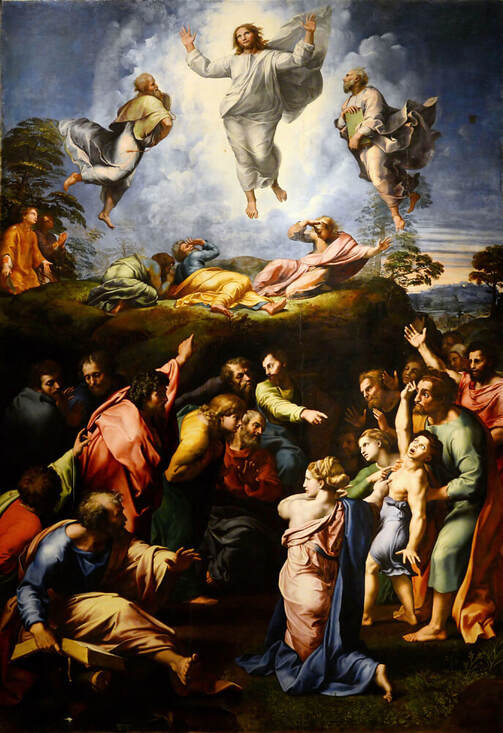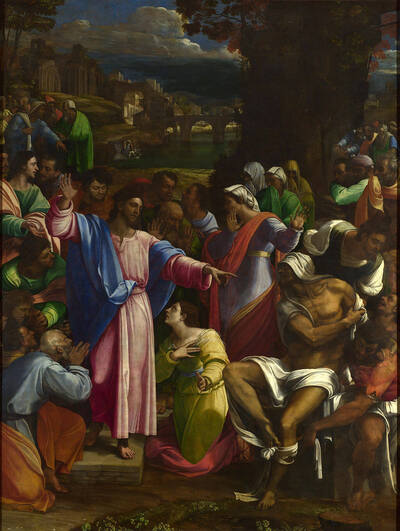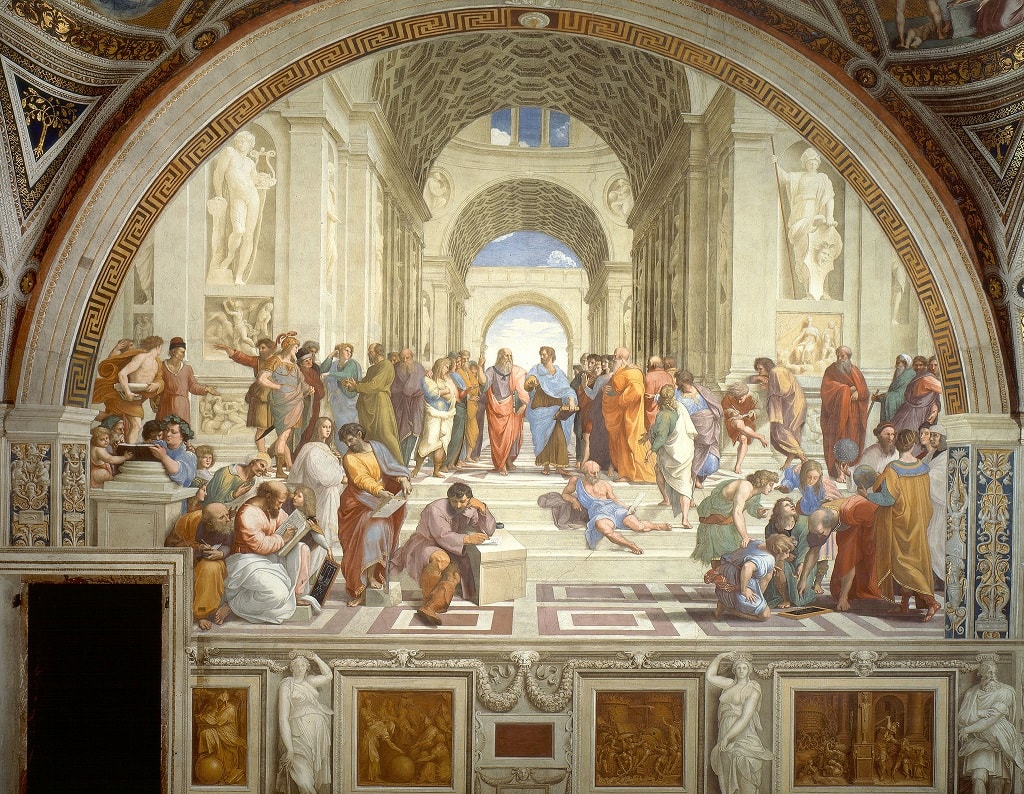|
Where? Room 8 of the Pinacoteca in the Vatican Museums
When? 1516-1520 Commissioned by? Archbishop Giulio de’ Medici (who later became Pope Clement VII) for a chapel in the Narbonne Cathedral in Narbonne, France. What do you see? Two unrelated biblical events. On top is the story of the transfiguration of Christ. At the bottom is the story of a young man who is possessed by a demon.
In 1523, the painting was placed in the San Pietro in Montorio Church in Rome. Over the centuries, numerous artists and art experts considered this to be the best painting ever.
Biblical stories: The story on top is the transfiguration and on the bottom is The Healing of the Lunatic Boy. Both stories are described in Matthew 17, Mark 9, and Luke 9. The biblical story describes how Jesus is transfigured in radiant glory when praying with three of his disciples on a mountain. Jesus speaks with Moses and Elijah and also hears the voice of God. The Feast of the Transfiguration is still celebrated in many churches, either on August 6 or August 19.
The story of the demon-possessed boy occurs at the same time as the transfiguration. When Jesus and his three disciples came down from the mountain, the father of the boy kneels down in front of Jesus and asks him to heal his son as the disciples were unable to do that. In 1605, Peter Paul Rubens painted a variation of the Transfiguration.
Symbolism: The transfiguration shows the connection that Jesus provides between Heaven and Earth and that people should follow the lessons provided by the Son of God. To emphasize this, Jesus is looking upwards to the sky to remind us that he provides the connection between the people on earth and God in Heaven. The three disciples on the mountain represent faith, hope, and love. The scene at the bottom half of the painting symbolizes the inability of people to do miracles without the trust in God's abilities.
Who is Raphael? Raffaello Sanzio da Urbino (1483-1520) was a very productive painter. Despite his short life, he completed many works. Together with Leonardo da Vinci and Michelangelo, he is considered to be the most influential painter of his time. The Transfiguration is considered to be one of Raphael's best works, only surpassed according to some by his fresco of the School of Athens, which is also in the Vatican Museums. The Transfiguration was ahead of its time. It contains some elements of both the Mannerism and Baroque style of painting, and it has had a big influence on the development of both styles. With such a masterpiece, it was a pity that Raphael died on Good Friday 1520. The painting of the Transfiguration was exposed next to the body of Raphael in the days after his death, and it was initially placed above his tomb in the Pantheon.
Fun fact: The story behind this painting has been debated for centuries as it was not clear why Raphael combined two such different biblical stories in a single painting. There are many explanations, but no consensus.
A first explanation is that Raphael was competing with Del Piombo who was commissioned a painting for the same church. After he saw the completed painting of Del Piombo, Raphael decided to add additional figures to the painting to outshine the painting of Del Piombo (a protégé of Michelangelo, Raphael’s biggest rival). A second interpretation is given by Johann Wolfgang von Goethe who wrote that the painting was clearly an integrated piece. At the bottom are the people who are suffering and need the help of Jesus (emphasized by the more chaotic and dark scene) and on the top is the power of Jesus which the people at the bottom need (emphasized by the serene and bright scene). A third interpretation is that Raphael combined these two scenes because of the meaning of his name. Raphael means ‘God heals’ in Hebrew. This would explain that the disciples at the bottom could not heal the young man, but that Jesus, through the power of God, could heal him. You can pick the interpretation that you prefer. Interested in a copy for yourself? Poster or canvas
Written by Eelco Kappe
References:
6 Comments
Ron
9/5/2017 09:07:59 am
Italian Journey 1786:
Reply
Sarah Patton
10/5/2021 03:03:32 pm
The woman kneeling grabs the eye even though she is never identified. Could it be Mary Magdalene? She could be saying, "He showed you the way!"
Reply
TripImprover
10/12/2021 11:12:31 am
It's an interesting suggestion and this woman has intrigued many over the centuries, as it is not very clear who she is or who she represents. As she is placed in between the family group on the right and the disciples on the left, she seems to have a distinct (bridging) role here. The most reasonable interpretation for me is that she represents the church on earth.
Reply
Sarah Patton
10/12/2021 12:12:46 pm
Thank you for answering. However all 11 disciples are named, omitting Mary Magdalene. Why would he paint a symbol of the church scantily dressed?
Reply
gary
1/8/2022 10:20:33 pm
How were Jesus’ post-death appearances to the disciples any different from Moses’ post-death appearance to the disciples?
Reply
Sandi
12/26/2022 07:38:02 am
Long after the disciples saw Moses and Elijah appear beside Jesus, children in Fatima and Lourdes saw Mary, the Mother of Jesus, appear before them. For these fortunate select, believing is seeing; the rest of us, the great unselected, tend to hold stubbornly fast to seeing is believing.
Reply
Leave a Reply. |
Categories
All
|
- Home
- Blog
-
Museums
- Alte Pinakothek
- Art Institute of Chicago
- Baltimore Museum of Art
- Barber Institute of Fine Arts
- Bargello
- Barnes Foundation
- British Museum
- Church of Sant’Anastasia
- Cleveland Museum of Art
- Courtauld Institute of Art
- Detroit Institute of Arts
- Frans Hals Museum
- Galleria Borghese
- Gallerie dell'Accademia
- Getty Museum
- Guggenheim
- Hermitage Museum
- Kunsthistorisches Museum
- Kunstmuseum Basel
- Legion of Honor Museum
- Louvre
- Mauritshuis
- Metropolitan Museum of Art
- Musee d’Orsay
- Museum of Fine Arts in Boston
- Museum of Modern Art
- National Gallery in London
- National Gallery of Art
- National Museum in Poznań
- Norton Simon Museum
- Ny Carlsberg Glyptotek
- Palace of Versailles
- Palazzo Pitti
- Palazzo Vecchio
- Petit Palais
- Philadelphia Museum of Art
- Prado
- Pushkin Museum
- Ravenna Art Museum
- Rijksmuseum
- San Diego Museum of Art
- Santa Maria delle Grazie
- St. Peter's Basilica
- Städel Museum
- Statens Museum for Kunst
- Tate Britain
- Tate Modern
- Timken Museum of Art
- Uffizi
- Vatican Museums
- Wallace Collection
-
Artists
- Altdorfer
- Anguissola
- Berlin Painter
- Bosch
- Botticelli
- Boucher
- Bronzino
- Bruegel the Elder
- Brunelleschi
- Cabanel
- Caillebotte
- Canova
- Caravaggio
- Carpeaux
- Cezanne
- Cimabue
- David
- Degas
- Delacroix
- De Maria
- Donatello
- El Greco
- Fontana
- Fra Angelico
- Fragonard
- Gauguin
- Gentileschi
- Gericault
- Gonzalez-Torres
- Goya
- Hals
- Hogarth
- Hokusai
- Ingres
- Leonardo da Vinci
- Lippi, Filippo
- Longhi, Barbara
- Lorrain
- Makovsky
- Manet
- Massys
- Matisse
- Merian
- Michelangelo
- Mochi
- Modigliani
- Monet
- Panini
- Parmigianino
- Perugino
- Picasso
- Pisanello
- Raphael
- Rembrandt
- Renoir
- Reynolds
- Rivera
- Rodin
- Rubens
- Scultori
- Seurat
- Steen
- Tintoretto
- Titian
- Toulouse-Lautrec
- Turner
- Uccello
- Van der Weyden
- Van Dyck
- Van Eyck
- Van Gogh
- Van Hemessen
- Vasari
- Velazquez
- Vermeer
- Veronese
- Vigée Le Brun
-
Locations
- Books
- About Us




